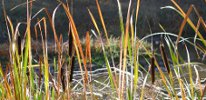
Training
The Ecology and Conservation of California's Maritime Chaparral
COST: FREE
REGISTRATION FOR THIS PROGRAM IS CLOSED
Instructor Information
Dr. Karen Holl
Professor
UC Santa Cruz Dept. of Environmental Studies
Dennis Odion
Research Biologist
UC Santa Barbara
Dr. Tom Parker
Professor
San Francisco State University
Claudia Tyler
Ecologist/Assistant Research Biologist
University of California, Santa Barbara
Eric Van Dyke
Geographical Ecologist
Elkhorn Slough National Estuarine Research Reserve
Contact
Grey Hayes
grey@elkhornslough.org
(831) 274-8700
Sponsors
Description
See also: Maritime Chaparral, Habitat Restoration
Conservation of one of the nation's most endangered shrub communities moved a giant step forward on January 17, 2003 during a workshop entitled "The Conservation and Ecology of California's Maritime Chaparral." A diverse group of land managers, researchers, and government personnel met at the Elkhorn Slough National Estuarine Research Reserve to meet each other and to learn about maritime chaparral. The specific goals of the workshop were to: network the leading scientists researching maritime chaparral, create consensus on a number of issues regarding this rare habitat type, and facilitate increased awareness of the conservation needs of the maritime chaparral plant community. The workshop featured 5 leading researchers in maritime chaparral: Karen Holl, Dennis Odion, Tom Parker, Claudia Tyler, and Eric Van Dyke. The day began with a presentation by Eric Van Dyke presenting a description and an overview of the extent of maritime chaparral in the Monterey Bay area. He then described his research with Karen Holl on the succession of maritime chaparral. In the late 1990's, Eric re-sampled transects first sampled by James Griffin in the Pajaro Hills in the mid 1970's. He and Karen then went on to describe the loss of maritime chaparral in the absence of fire to coast live oak woodland. Karen Holl then presented on the pressing issues for research and management in order to better conserve maritime chaparral. The next presentation was by Dennis Odion who presented data from his and Claudia Tyler's research in both Santa Barbara and San Luis Obispo counties. In Santa Barbara, these researchers mapped historical fire patterns and examined seed bank and plant community dynamics. Through examining a number of stands of varying ages, they are able to predict the changes in maritime chaparral over time following a fire. In Morro Bay, after sampling the seed bank and baseline vegetation conditions, they oversaw a prescribed fire in an area dominated by Morro manzanita. Their results indicate the need for extreme caution if fires are more frequent than perhaps every 60 years in that vegetation association: this is the time period necessary for manzanitas to replenish the necessary number of seeds in the seed bank to replace adults lost in a fire. The last presentation was by Tom Parker, who spoke about the diversity and evolution of manzanitas, their universal adaptation to fire, and their interesting association with a rich assortment of mycorrhizal fungus. Just before a catered lunch, we were able to engage the scientist presenters to answer the numerous questions from the audience. After lunch, the afternoon brought a field trip to Manzanita Park, where there were some formal presentations by various experts on recognizing species, interpreting historical disturbances, and the historical ecology of Native American land management. In summary, participants learned a number of things, including: how to identify maritime chaparral, how biologically diverse maritime chaparral is, how many rare species inhabit this ecosystem, management concerns with maintaining maritime chaparral habitat and species, and research priorities for maritime chaparral. Until this workshop (and some work before and after), there was little consensus about what constitutes maritime chaparral. Now, we have a working definition (see Appendix 8), which includes references to current and previous literature on the subject. After the workshop, we also have a working list of all of the rare organisms associated with this habitat type per county (see Appendices 1-7). Presenters also made several management concerns quite clear. First, we learned that maritime chaparral depends on fire for its long-term viability; but, it is vulnerable to too infrequent or frequent fire. Too infrequent fire causes the encroachment of live oaks and the decline of species unable to thrive either in the shade or in the long-term seed bank. Too frequent fire may convert maritime chaparral to species-poor coastal scrub or non-native grassland. Second, we learned that urban development and agriculture has greatly reduced large areas of maritime chaparral around the Pajaro Hills and near Monterey, threatening the viability of various populations of rare species associated with the habitat. Third, we learned that much of the diversity of maritime chaparral lies below the soil surface in long-lived seeds and a wealth of mycorrhizal fungi species that are vulnerable to fire during the season when the soil is moist. Some species in the seed bank may survive for hundreds of years in areas that appear now as oak or pine woodland. The mycorrhizal fungi may actually facilitate the invasion of conifers into chaparral habitat. With research priorities, the group conceded that the most important research was also the hardest: experiments with prescribed fire and mechanical clearing replicated across the large landscape, up and down California. This level of coordination is often difficult but necessary to explore methods of maintaining this fire-dependent ecosystem in the matrix of human habitation. Although not well documented, the model for maintaining maritime chaparral probably was well developed by humans once before - the Native Americans managed fire in this habitat type for over 15,000 years. Future managers may have to reinvent methodology for species conservation and sustainable co-habitation with the myriad of species associated with this beautiful shrub dominated ecosystem. For more information about maritime chaparral, or to obtain a video tape of highlights of the workshop, contact Grey Hayes at grey@elkhornslough.org or (831) 728-2822.
Documents and Publications
Links
Where do I get funding to help preserve rare habitats like maritime chaparral?
http://grants.fws.gov/state.html
Questions and Answers
Submit a question on this subject and we'll provide an answer. coastaltraining@elkhornsloughctp.org
